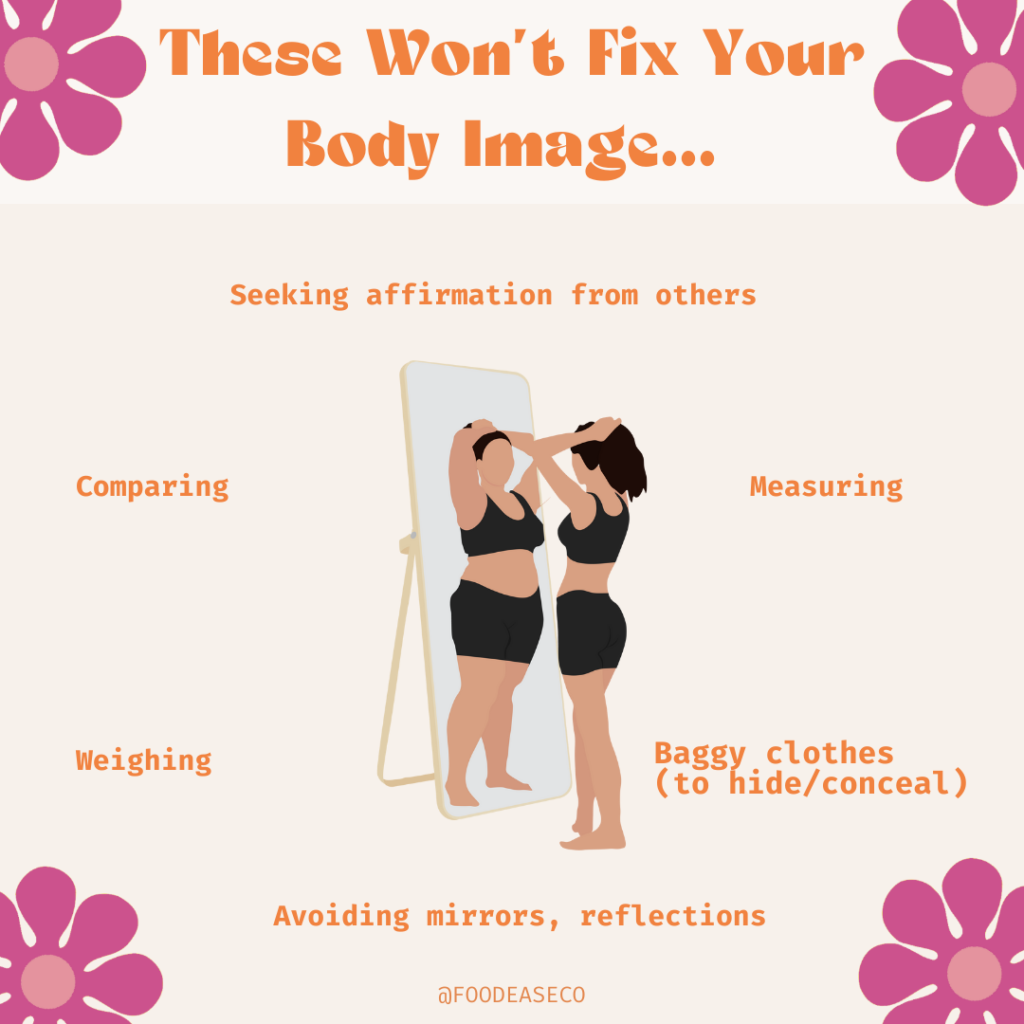Body Checking and Body Avoidance

Introduction
Last week we looked at what body image is. As we continue with the theme of body image-related topics, this week we are going to discuss what body checking and body avoidance are.
Body avoidance and body checking are similar in that they are used as coping mechanisms used by individuals who have severe concerns regarding body weight and shape.
Body Checking
Body checking is an unsustainable coping strategy used to manage anxiety in those who are fearful of body changes such as weight gain or shape [1]. These behaviors are done so individuals can confirm that what they are fearful of (body changes) is not happening.
Body Checking Behaviors:
- Weighing: body weighing is one of the more common body checking behaviors that involves checking one’s body weight multiple times a week or day.
- Mirroring: frequently looking at one’s body in mirrors, windows, or other objects where reflections can be seen in.
- Measuring: measuring one’s body parts such as the waist, wrist, and thighs using either a measuring tape or wrapping one’s hands around body parts to check for changes in size.
- Pinching: grabbing/pinching flesh on certain body parts such as the stomach or arms and measuring by how much one can hold between their fingers.
- Tracing: tracing often happens subconsciously and is when individuals run their fingers along areas of the body which do not have a lot of muscle or fat – mainly bone. The collar bone is most commonly a location that is traced.
- Questioning: Asking other individuals questions about one’s body to seek reassurance about their body weight or shape.
- Comparing: Comparing one’s body to others or past photos of oneself.
Body Avoidance
Body avoidance is the opposite of body checking behavior and is instead engaging in body-related avoidant behaviors [3]. It is important to note that some of the following avoidant behaviors may be helpful during different stages of body acceptance. However, the end goal is that body weight and shape have no power over an individual’s life choices/decision
Body Avoidance Behaviors [2]:
- Avoiding mirrors, reflections, or pictures of oneself
- Avoiding form-fitting clothes and wearing baggy clothes to disguise shape or size
- Avoiding weather-appropriate clothes or activities that may bring attention to your body (swimsuits, shorts)
- Avoiding close physical contact with others
Challenging Body Checking and Body Avoidance Behaviors
- Reflection: now that you have an understanding of what body avoidance and body checking behaviors are, check in with yourself and identify what behaviors you may engage in. Take a full day and keep a tally for how many times you engage in one specific behavior. Reflect on which areas/parts of your body that you perform these behaviors on.
- Goal Setting: Identify one body checking or avoidance behavior that you feel you will be able to challenge. Start small in your goal setting and work on gradually reducing that behavior. You can start by trying to be more mindful and stop yourself when you start to body check or avoid. Once one body checking or avoidance behavior has been challenged you can start to work on another behavior.
Why This Matters AND How We Can Help!
Body checking and body avoidance only provide individuals with short-term body image anxiety relief. Long-term relief can be obtained by challenging these behaviors and working with a body image therapist or participating in group sessions like what we have planned here at Food Ease Co! Send us an email to schedule a FREE 15-minute discovery call to see if our services could be right for you.
References:
[1] Change, C. C. (2022, August 3). Body Checking. Change Creates Change. https://changecreateschange.com/body-checking/
[2] Michel, A. (2021, September 22). Body Checking and Body Avoidance. The Emily Program. https://www.emilyprogram.com/blog/body-checking-and-body-avoidance/
[3] Nikodijevic, A., Buck, K., Fuller-Tyszkiewicz, M., de Paoli, T., & Krug, I. (2018, March 12). Body checking and body avoidance in eating disorders: Systematic review and meta-analysis. European Eating Disorders Review, 26(3), 159–185. https://doi.org/10.1002/erv.2585
Have a Question?


Do you have any questions or suggestions? Feel free to contact us! Just leave your email here, and we will get back to you shortly.